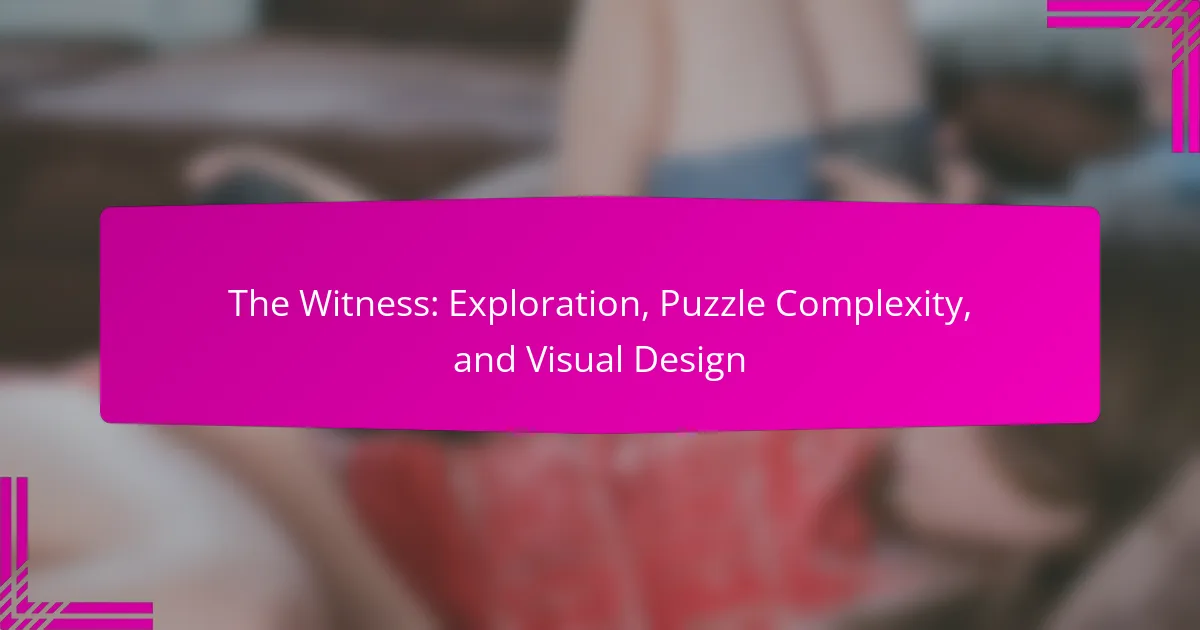The Witness offers a unique gaming experience through its engaging exploration, intricate puzzle complexity, and stunning visual design. Players navigate a beautifully crafted world that encourages discovery and critical thinking. The puzzles evolve in complexity and are seamlessly integrated with the environment. Vibrant visuals enhance immersion, guiding players through challenges that are both intellectually stimulating and visually rewarding.
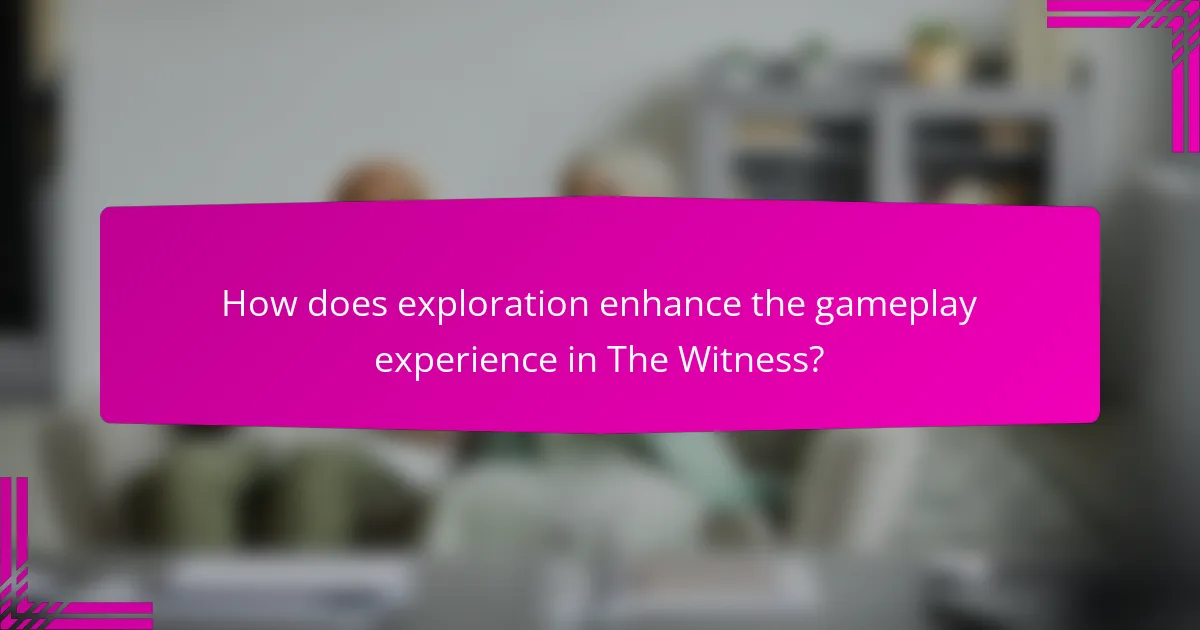
How does exploration enhance the gameplay experience in The Witness?
Exploration significantly enhances the gameplay experience in The Witness by encouraging player engagement and discovery. Players navigate a beautifully crafted world filled with intricate puzzles that rely on observation and environmental interaction. This exploration fosters a sense of accomplishment, as players uncover hidden areas and solutions, deepening their connection to the game’s narrative and visual design. The complexity of puzzles is often tied to the environment, requiring players to think critically about their surroundings. The unique attribute of The Witness lies in its seamless integration of exploration and puzzle-solving, making each discovery feel rewarding and essential to progression.
What are the different exploration techniques used in The Witness?
The Witness employs various exploration techniques to enhance player engagement and puzzle-solving. Key techniques include environmental storytelling, visual cues, and spatial awareness.
Environmental storytelling allows players to glean insights into the game world through its design and layout. Visual cues guide players toward puzzles and objectives, creating a seamless navigation experience. Spatial awareness encourages players to observe their surroundings and consider the relationship between different areas.
These techniques collectively contribute to the game’s immersive experience and challenge players to think critically about their environment.
Why is environmental storytelling significant in The Witness?
Environmental storytelling is significant in The Witness because it immerses players in a rich, interactive world. The game’s design encourages exploration, where each environment reveals clues and narratives through visual cues. This approach enhances puzzle complexity, as players must engage with their surroundings to uncover solutions. The seamless integration of visual design and narrative fosters a deeper connection to the game, making the experience more meaningful. The unique attribute of The Witness lies in its ability to convey a story without explicit dialogue, relying instead on environmental elements to guide player understanding.
Which areas of the game world offer unique exploration challenges?
The Witness features several areas that present unique exploration challenges. The island’s diverse environments, such as the desert and the jungle, offer distinct puzzles that require different problem-solving approaches. Each area encourages players to adapt their strategies, enhancing the overall experience. The intricate visual design complements these challenges, creating an immersive exploration atmosphere. Players must navigate various terrains while deciphering clues and understanding environmental cues.
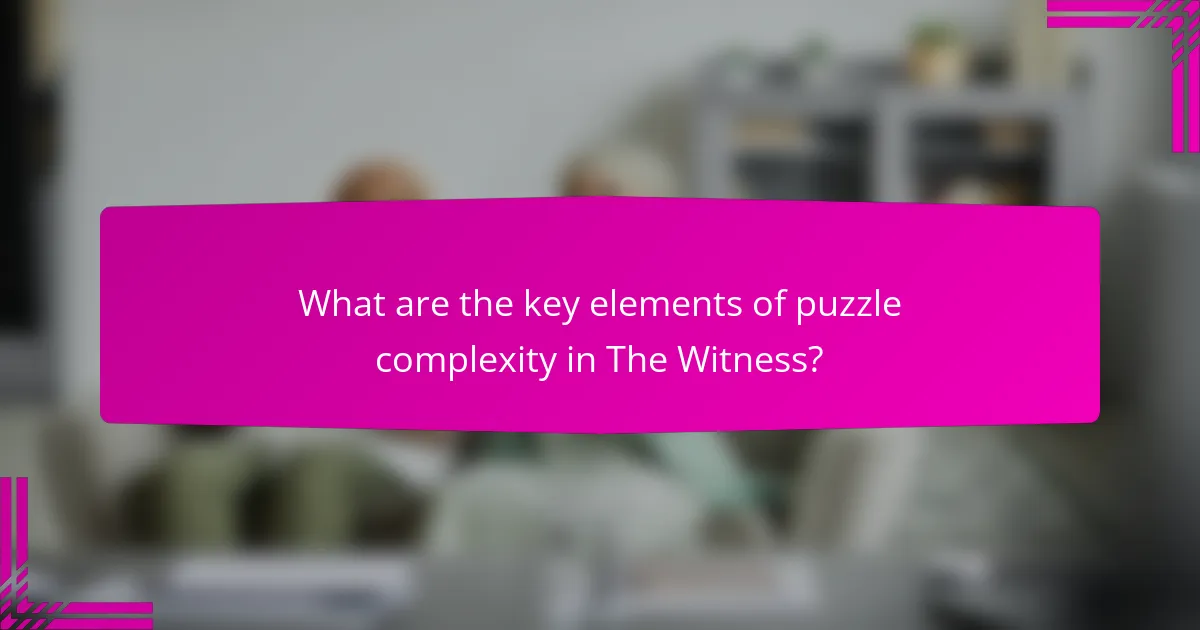
What are the key elements of puzzle complexity in The Witness?
The key elements of puzzle complexity in The Witness include varied mechanics, increasing difficulty, and environmental integration. Puzzles evolve in complexity by introducing new rules and layering challenges. Each puzzle’s design encourages exploration and observation, often requiring players to utilize visual cues and spatial reasoning. The interconnectedness of puzzles within the environment enhances the overall complexity, creating a rich and immersive experience.
How do puzzles evolve in difficulty throughout the game?
Puzzles in The Witness increase in difficulty through layered complexity and environmental clues. Initially, players encounter simple patterns, gradually introducing more intricate mechanics and combinations. This evolution challenges players to apply learned skills and adapt strategies. Unique attributes, such as the integration of visual design and narrative elements, enhance the puzzle-solving experience, making it engaging and rewarding.
What role does player intuition play in solving puzzles?
Player intuition is crucial for solving puzzles in The Witness, enhancing engagement and exploration. Intuitive thinking allows players to recognize patterns and relationships in the game’s visual design, facilitating puzzle completion. The complexity of puzzles encourages players to trust their instincts, leading to a deeper understanding of the game’s mechanics. This interplay between intuition and puzzle-solving fosters a rewarding experience, making each discovery feel personal and satisfying.
Which puzzles are considered the most challenging and why?
The Witness is considered one of the most challenging puzzles due to its intricate design and layered complexity. Players must navigate a vast island filled with environmental puzzles that require keen observation and critical thinking. The unique attribute of The Witness is its reliance on visual cues and patterns, which often necessitate a deep understanding of the game’s mechanics. Additionally, the lack of explicit instructions increases the difficulty, demanding players to discover solutions independently. This combination of factors contributes to its reputation as a formidable challenge in the puzzle genre.
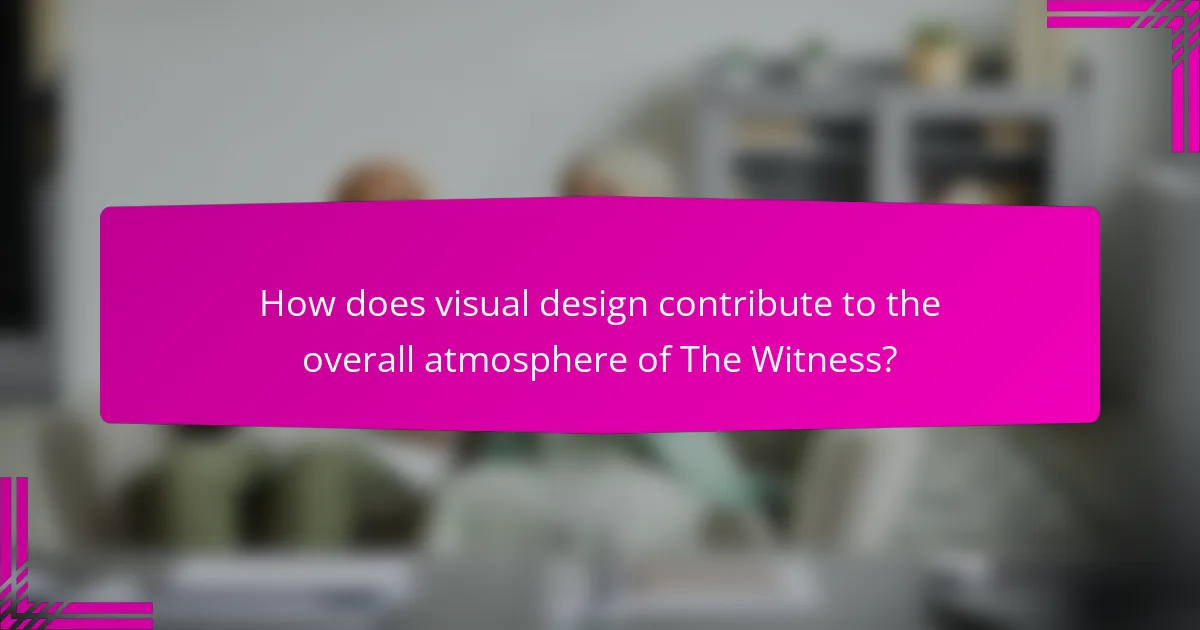
How does visual design contribute to the overall atmosphere of The Witness?
Visual design significantly enhances the atmosphere of The Witness by creating an immersive experience. The game’s vibrant colors and intricate landscapes evoke emotions, guiding players through exploration. Unique attributes like the interplay of light and shadow add depth, while carefully crafted environments encourage puzzle-solving. This synergy between visual elements and gameplay fosters a contemplative atmosphere, making the experience memorable.
What artistic styles influence the visual design of The Witness?
The visual design of The Witness is influenced by minimalist art, modernism, and natural landscapes. These styles emphasize simplicity, color theory, and spatial awareness. Minimalist art contributes to the game’s clean aesthetic, allowing players to focus on puzzles without distraction. Modernism’s emphasis on form and function enhances the game’s architectural elements. Natural landscapes inspire the vibrant environments, creating a harmonious blend of art and gameplay.
How does color theory impact player perception in The Witness?
Color theory significantly shapes player perception in The Witness by influencing emotional responses and problem-solving strategies. The game employs a vibrant color palette to enhance spatial awareness and guide players through complex puzzles. Each color represents distinct challenges, affecting how players interpret visual cues. For example, warm colors may evoke urgency, while cool colors might promote calmness. This strategic use of color fosters engagement and aids in navigating the game’s intricate environments. Overall, color theory in The Witness is a crucial element that enhances the player’s experience and interaction with the game’s design.
Which design elements create immersion in the game world?
Immersion in The Witness is created through environmental storytelling, intricate puzzles, and stunning visual design. The game world invites exploration, enhancing player engagement.
Key design elements include:
– **Visual Aesthetics**: Vibrant colors and detailed landscapes create a captivating atmosphere.
– **Puzzle Complexity**: Layered puzzles encourage deep thinking and discovery.
– **Sound Design**: Ambient sounds enhance immersion, making the environment feel alive.
– **Non-linear Exploration**: Open-world design allows players to engage with the environment at their own pace.
– **Environmental Cues**: Subtle hints guide players, reinforcing the connection between the puzzles and the landscape.
These elements collectively foster a rich, immersive experience, drawing players into the game’s unique world.
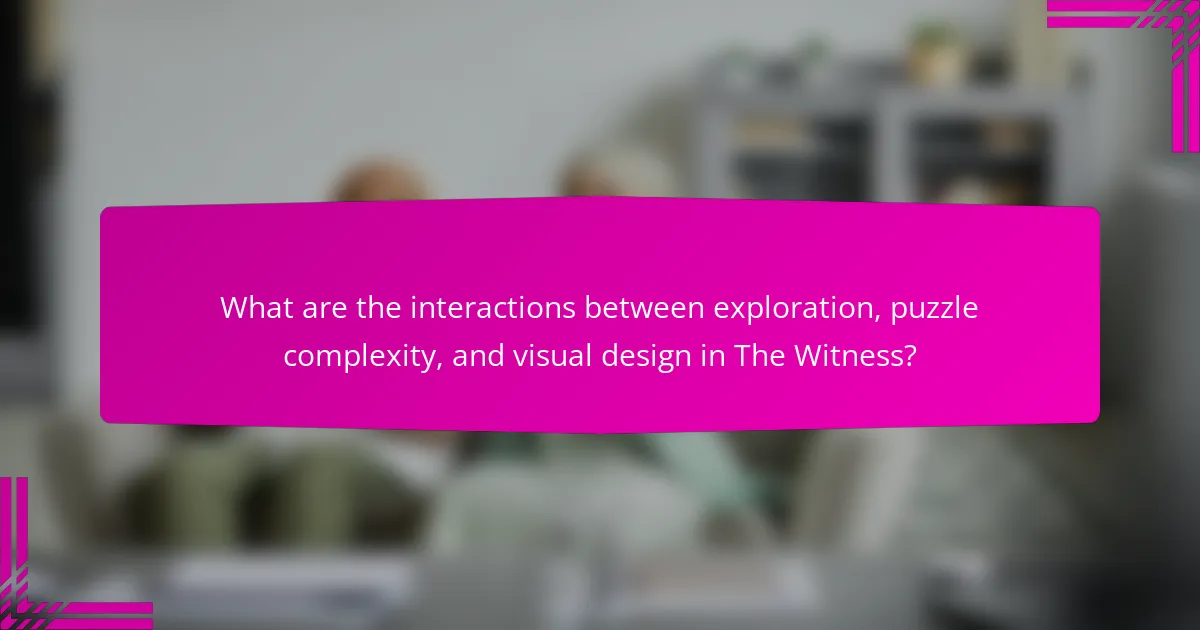
What are the interactions between exploration, puzzle complexity, and visual design in The Witness?
The interactions between exploration, puzzle complexity, and visual design in The Witness create a cohesive gameplay experience. Exploration encourages players to engage with the environment, revealing intricate puzzles that challenge cognitive skills. Visual design enhances this interaction by providing clear visual cues and immersive landscapes, guiding players through the game world. The balance of these elements ensures that players remain invested, as they navigate through complex challenges that are visually rewarding. Each puzzle’s design reflects the game’s aesthetic, reinforcing the connection between visual appeal and intellectual engagement.
How do these elements work together to create a cohesive gameplay experience?
The Witness creates a cohesive gameplay experience through seamless exploration, intricate puzzle complexity, and striking visual design. These elements interconnect to enhance player immersion and engagement. Exploration encourages players to interact with the environment, discovering clues that inform puzzle-solving. Puzzle complexity challenges players intellectually, fostering a sense of achievement upon completion. Visual design captivates players, creating an aesthetically pleasing world that complements gameplay mechanics. Together, these aspects form a harmonious blend that enriches the overall experience.
What feedback do players provide on the integration of these aspects?
Players generally appreciate the integration of exploration, puzzle complexity, and visual design in The Witness. They highlight how the interconnectedness of these aspects enhances immersion and engagement. The vibrant visuals and intricate puzzles create a captivating environment that encourages players to think critically. Feedback often emphasizes the satisfaction derived from solving complex puzzles that are seamlessly integrated into the landscape, enhancing the overall experience. Players find that this design approach fosters a sense of discovery and accomplishment throughout their journey.
How can the balance of exploration, puzzles, and visuals be optimized for player satisfaction?
Balancing exploration, puzzles, and visuals in The Witness enhances player satisfaction through engaging gameplay. Players appreciate an open-world design that encourages discovery, coupled with intricate puzzles that challenge their thinking. The stunning visuals create an immersive environment, reinforcing the sense of exploration.
Optimizing this balance involves ensuring puzzle complexity aligns with visual cues, guiding players without explicit instructions. For example, subtle visual hints can lead to puzzle solutions while maintaining exploration’s rewarding nature.
Ultimately, the interplay between these elements fosters a sense of achievement, driving player engagement and satisfaction throughout the experience.
What best practices can enhance the enjoyment of The Witness?
To enhance enjoyment of The Witness, focus on exploration, puzzle complexity, and visual design. Engage with the environment to uncover hidden clues and patterns. Embrace the challenge of puzzles, as they stimulate critical thinking and creativity. Appreciate the stunning visuals, which create an immersive experience and evoke emotional responses. Take breaks to prevent frustration and maintain enjoyment. Sharing discoveries with others can also enrich the experience.
